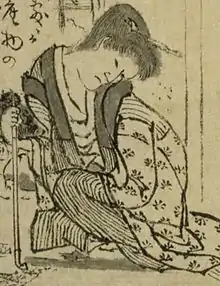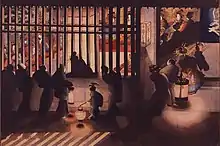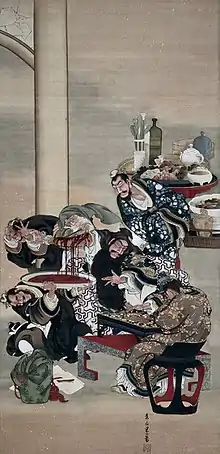Katsushika Ōi
Katsushika Ōi (葛飾 応為, c. 1800 – c. 1866), also known as Ei[1] (栄), was a Japanese Ukiyo-e artist of the early 19th century Edo period. Her mother was the second wife of Hokusai. Ōi was an accomplished painter who also worked as a production assistant to her father.[2][3]
Katsushika Ōi (葛飾 応為) | |
|---|---|
 Katsushika Ōi in the mid-1840s | |
| Born | c. 1800 (exact date unknown) |
| Died | c. 1866 (exact date unknown) |
| Nationality | Japanese |
| Known for | Ukiyo-e |


Biography
Ōi's birth and death dates are not known. She was a daughter of the ukiyo-e artist Katsushika Hokusai (1760—1849).[4][5] Hokusai was married twice; the first marriage[lower-alpha 1] produced a son and two daughters, and the second, to a woman named Koto (こと), resulted in a son and one or two daughters.[6] It is said that Ōi was born in Hokusai's 37th year:[4] Kansei 12 (c. 1800).[6]
Ōi married the artist Minamisawa Tōmei[lower-alpha 2] in c. 1824. They did not get along,[6] and she found him a comically poor artist.[4] They divorced about 1827;[6] she returned to her father's home and never remarried.[4] Ōi thereafter assisted Hokusai in his artwork and took to producing her own. Of her bijin-ga portraits of beauties Hokusai is said to have told people, "The bijin-ga I paint myself are no match for Oei's."[lower-alpha 3] Ōi's mother died in c. 1828.[6] Ōi's whereabouts and status become unknown within a few years of her father's death in 1849.[4]
Ōi not only shared the artistic talent of her father, but also his characteristic of a free spirit. Both of them did not care about material wealth and keeping up with housework. Ōi and her father painted all day, and as neither one cooked they would go to a nearby market and buy prepared food. After a while when it became too unsuitable to live, they would go and find another place to live.[7]
Of the testimony that remains about Ōi, Tsuyuki Iitsu, a pupil of Hokusai's in the master's later years, described her as having an eccentric personality like her father and a charitable disposition—she had ambitions to become a female xian sage.[4]
Works
Ōi is known to have excelled at handwriting and in bijin-ga paintings of beautiful women. The following is a selected list of her works.
- Kinuta a.k.a. Beauty Fulling Cloth in the Moonlight (date unknown) — Single-sheet woodblock print. Tokyo National Museum collection.
- Yoshiwara Night Scene (date unknown) — The parts of her name can be observed in this scene, distributed over three different lanterns tagged with symbols "O", "i", and "Ei". Ukiyo-e Ōta Memorial Museum of Art collection.
- Kuruwa in Grid View (date unknown) — Ukiyo-e Ōta Memorial Museum of Art collection.
- Beauty of Spring Night (date unknown) — Menard Art Museum collection.
- Hundred Eyes (date unknown) — Hokusai Museum collection.
- Mount Fuji through a Bamboo Forest (date unknown) — Hanging scroll; ink and color on silk. Hokusai Museum collection.
- Three Women Playing Musical Instruments (c. 1818–1844, i.e. Bunsei to Tenpō era) – Hanging scroll; ink and color on silk. Museum of Fine Arts, Boston, collection.
- Operating on Guanyu's Arm (c. 1818–1854) — Hanging scroll; ink, color and gold leaf on silk. – Cleveland Museum of Art collection.

- One Thousand Years of Hyakunin isshu Yamato Longevity (1829)[2] — Pictorial.
She has also been credited as an illustrator for the following books.
- Illustrated Handbook for Daily Life for Women (1847) — Woodblock printed book. Ravicz Collection.[8]
- A Concise Dictionary of Sencha (1848)[9]
Aside from drawing and painting, Ōi also made keshi ningyō dolls and sold them to earn a living.[10]
Legacy
Few of Ōi's works are known: amongst them, a few nikuhitsu-ga paintings, the illustrations to the book Onna Chōhō-ki (女重宝記, 1847) by Takai Ranzan (高井 蘭山), and no prints.[4]
Canadian novelist Katherine Govier wrote a first-person novel about Ōi titled The Ghost Brush (2010,[11] also titled The Printmaker's Daughter).[12]
The story of Ōi was adapted to comics as Miss Hokusai (1983–87), which had an animated movie adaptation in 2015. The story tells of the outspoken O-Ei, daughter of the famed artist Tetsuzō, for whom she sometimes paints uncredited. The film won numerous awards.[13]
Katsushika Ōi also appears in Fate/Grand Order as both a Foreigner-class and Saber-class Servant, serving as a body for her father, Katsushika Hokusai. Hokusai himself accompanies her as a floating octopus. Her signature moves are based on The Great Wave off Kanagawa and A Tour of the Waterfalls of the Provinces, both painted by her father.[14]
Makate Asai based her novel Kurara on the life of Ōi; it was published in 2016 after serialization in 2014–15, and an NHK television adaptation of it titled Kurara: Hokusai no Musume ("Kurara: Hokusai's Daughter") appeared in 2017, starring Aoi Miyazaki.
See also
Notes
References
- "葛飾, 応為 カツシカ, オウイ" (in Japanese). CiNii. Retrieved May 22, 2017.
- Ōi, Katsushika (1829). Senzai Hyakunin isshu yamato-kotobuki 千歳百人 一首倭寿.
- Machotka, Ewa (2009). Visual Genesis of Japanese National Identity: Hokusai's Hyakunin Isshu. Peter Lang. ISBN 978-90-5201-482-1.
- Kamiya 2006, p. 116.
- Phaidon Editors (2019). Great women artists. Phaidon Press. p. 210. ISBN 978-0714878775.
- Suzuki 2016, p. 188.
- 1953-, Fister, Pat (1988). Japanese women artists, 1600-1900. Yamamoto, Fumiko Y., Helen Foresman Spencer Museum of Art., Honolulu Academy of Arts. (1st ed.). Lawrence: Spencer Museum of Art, University of Kansas. ISBN 9780913689257. OCLC 17682726.CS1 maint: numeric names: authors list (link)
- Fister, Pat (1988). Japanese women artists, 1600–1900. Yamamoto, Fumiko Y., Helen Foresman Spencer Museum of Art., Honolulu Academy of Arts. (1st ed.). Lawrence: Spencer Museum of Art, University of Kansas. ISBN 9780913689257. OCLC 17682726.
- Kobayashi Tadashi and Julie Nelson Davis. "The Floating World in Light and Shadow: Ukiyo-e Paintings by Hokusai's Daughter Oi". in Carpenter, J. T. et al (eds). Hokusai and his age: Ukiyo-e painting, printmaking and book illustration in late Edo Japan. Amsterdam: Hotei Publishing. 2005.
- Fister, Pat (1988). Japanese women artists, 1600–1900. Yamamoto, Fumiko Y., Helen Foresman Spencer Museum of Art., Honolulu Academy of Arts. (1st ed.). Lawrence: Spencer Museum of Art, University of Kansas. ISBN 9780913689257. OCLC 17682726.
- Hanrahan 2010.
- Tanabe 2011.
- "Director Keiichi Hara Wins Asiagraph 2015 Tsumugi Prize for Miss Hokusai Film". Anime News Network. August 11, 2015. Archived from the original on 2015-10-20. Retrieved October 19, 2015.
- https://fategrandorder.fandom.com/wiki/Katsushika_Hokusai
Bibliography
- Hanrahan, Catherine (2010-05-28). "Review: Fiction: Under the Great Wave". The Globe and Mail. Retrieved 2016-06-17.CS1 maint: ref=harv (link)
- Kamiya, Hiroshi (2006). "Katsushika Ōi". In Kobayashi, Tadashi (ed.). Ukiyo eshi retsuden 浮世絵師列伝. Bessatsu Taiyō (in Japanese). Heibonsha. p. 116. ISBN 978-4-582-94493-8.CS1 maint: ref=harv (link)
- Suzuki, Yukiko (2016). Ukiyo-e no Onna-tachi 浮世絵の女たち [Women of Ukiyo-e] (in Japanese). Gentosha. ISBN 978-4-344-02950-7.CS1 maint: ref=harv (link)
- Tanabe, Kunio Francis (2011-12-26). "Book World: Art and artifice in Katherine Govier's Printmaker's Daughter". Retrieved 2016-06-17.CS1 maint: ref=harv (link)
External links
 Media related to Katsushika Ōi at Wikimedia Commons
Media related to Katsushika Ōi at Wikimedia Commons